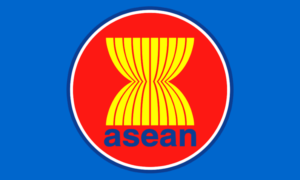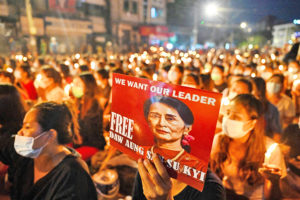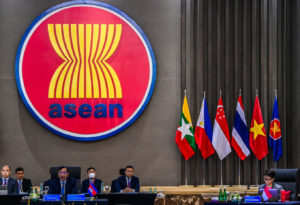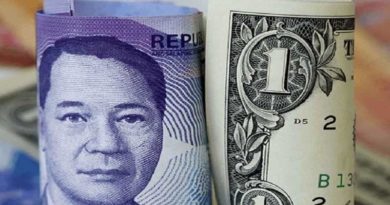OP ED | OPINION | ASEAN’s Challenges in Addressing the Myanmar Crisis
Myanmar’s permanent secretary of foreign affairs, Aung Kyaw Moe, far left, joins other high-ranking officials from ASEAN member nations at the organization’s summit in Vientiane, Laos, on Oct. 8. 2024. This was the first time in three years that Myanmar was represented. AFP
.




FREE ASEAN –
FREE MYANMAR/CAMBODIA/THAILAND /LAOS
FREE Aung San Suu Kyi

The ongoing crisis in Myanmar, particularly following the military coup in February 2021, presents a significant challenge not only for the country itself but also for the Association of Southeast Asian Nations (ASEAN). As a regional bloc that promotes cooperation and stability among its ten member states, ASEAN finds itself grappling with fundamental dilemmas in its approach to Myanmar’s situation. The complexities surrounding this issue raise questions about ASEAN’s effectiveness and the implications of its actions (or inactions) in addressing the humanitarian and political crises unfolding in Myanmar.

One of the core principles guiding ASEAN is the doctrine of non-interference in the internal affairs of member states. While this principle has historically fostered a spirit of cooperation and mutual respect among diverse nations, it poses a significant limitation in crises like that of Myanmar.
The military coup, accompanied by widespread human rights abuses and violent repression of dissent, necessitates urgent intervention and dialogue.
However, ASEAN’s commitment to non-interference often results in a reluctance to take decisive action or impose sanctions, hindering any meaningful response to the escalating crisis.
Moreover, ASEAN’s member states have diverse political systems, economic interests, and foreign policy priorities, complicating collective decision-making. Countries like Thailand and Malaysia, for instance, have different historical and political relationships with Myanmar, influencing their perspectives on how to approach the situation. This diversity can lead to disagreements within ASEAN, making it challenging to adopt a unified stance. The inability to project a cohesive front not only undermines ASEAN’s credibility but also diminishes its potential to act as a mediator in the crisis.
Another significant factor is ASEAN’s limited leverage over Myanmar’s military junta. While the bloc can offer dialogue and support, it lacks the political or economic clout to compel significant changes in Myanmar’s governance or human rights practices. Initiatives such as the Five-Point Consensus, proposed by ASEAN leaders to facilitate dialogue and restore stability, have seen limited success. Many critics argue that such measures fall short of addressing the root causes of the crisis and often result in little more than symbolic gestures. The effectiveness of engagement strategies has been questioned, leading to skepticism about ASEAN’s role and its ability to influence positive change.
Regional stability concerns also play a critical role in shaping ASEAN’s response. Some member states may prioritize maintaining stability in the region over addressing human rights violations in Myanmar. This perspective can result in a reluctance to take stronger actions against the junta, fearing that such measures could exacerbate tensions, lead to further instability, or even trigger a refugee crisis. The balance between advocating for human rights and ensuring regional security creates a complex dynamic that complicates ASEAN’s ability to respond effectively.
Furthermore, the expectations of the international community add another layer of pressure on ASEAN. Many external observers look to ASEAN to take a leading role in resolving the Myanmar crisis, given its regional proximity and influence. However, the bloc’s internal dynamics and commitment to non-interference often clash with these expectations, complicating its position on the global stage. Balancing these external pressures with its foundational principles and member state interests presents a significant challenge for ASEAN.

To navigate these challenges, ASEAN could consider several potential solutions:
1. Revisiting the Non-Interference Principle: ASEAN may need to reconsider its commitment to the principle of non-interference, particularly in situations where gross human rights violations are occurring.
2. Establishing a framework that allows for limited intervention in cases of humanitarian crises could enable more effective responses and demonstrate a commitment to regional stability and human rights.
3. Strengthening Diplomatic Engagement: ASEAN should enhance its diplomatic engagement with Myanmar, leveraging its status as a regional organization to facilitate dialogue between the military junta and opposition groups. This could involve appointing a special envoy with a mandate to engage all stakeholders and promote a peaceful resolution to the crisis.
4. Coordinating a Regional Response: A coordinated approach among ASEAN member states can amplify efforts to address the situation. By presenting a united front, ASEAN can enhance its bargaining power and potentially influence the junta’s actions. This may involve crafting a common position on sanctions, humanitarian aid, and support for civil society groups within Myanmar.

5. Involving External Partners: ASEAN could benefit from greater collaboration with external partners, including the United Nations and influential countries like the United States and China. By engaging these actors, ASEAN can gain additional leverage and resources to address the crisis effectively.
6. Prioritizing Humanitarian Assistance: ASEAN should prioritize humanitarian assistance to those affected by the crisis in Myanmar. This could involve establishing a regional fund to support humanitarian efforts, ensuring that aid reaches those in need while navigating the complexities of working with the junta.
7. Promoting Civil Society Engagement: Engaging with civil society organizations within Myanmar can provide valuable insights and support grassroots efforts for democracy and human rights. ASEAN can facilitate platforms for these organizations to voice their concerns and contribute to national dialogue.
8. Monitoring and Reporting Mechanisms: Establishing transparent monitoring and reporting mechanisms can help ASEAN stay informed about the evolving situation in Myanmar. Regular assessments of the political and humanitarian landscape would enable the organization to adjust its strategies and responses accordingly.

In conclusion, while ASEAN seeks to address the situation in Myanmar, its ability to effectively solve these issues is hampered by fundamental principles, diverse member interests, and limited leverage. However, by considering potential solutions such as revisiting its non-interference stance, strengthening diplomatic engagement, and collaborating with external partners, ASEAN can enhance its role as a mediator and advocate for stability and human rights in Myanmar. The ongoing crisis highlights the complexities of regional diplomacy and the urgent need for a proactive and cohesive approach to support the people of Myanmar in their quest for peace and democracy. As the situation continues to evolve, ASEAN’s credibility and effectiveness as a regional organization will depend on its willingness to adapt and respond meaningfully to these pressing challenges.
The author is a researcher based at the Royal Academy of Cambodia. He holds MPM from KDI School of Public Policy and Management [Public Administration & Leadership and Global Governance & Political Economy] and MEd from Royal University of Phnom Penh [Managing and Planning]. The views expressed here are his own
..
Ads by:



 Memento Maxima Digital Marketing
Memento Maxima Digital Marketing











